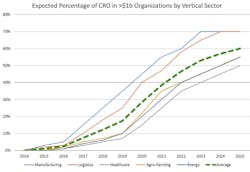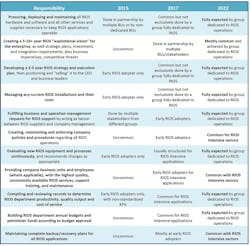Chief executive officer, Chief financial officer, and chief operation officer are among the better-known titles in the C-suite of upper management. After all, these roles are staples in the executive world. New to this lineup is the role of chief robotics officer (CRO). This individual is in charge of implementing the executive strategic approach to bringing automation into the manufacturing process.
The percentage of the role of CRO in different industry verticals is highlighted in the graph above. Manufacturing and logistics are both driving the demand for CRO. (Credit: Robotic Business Review)
According to the Robotic Business Review, by 2025 more than 60% of the top global companies in manufacturing, logistics, healthcare, energy, and agriculture will include a CRO organization as part of their corporate structure. The role will be one closely structured to that of a chief intelligence officer (CIO). The rapid expansion of robots and automated systems in the workplace resembles the previous expansion of computers. That earlier transition brought with it a need for oversight of network demands, internet connections, security, and digital file management.
Robotic automation systems have similar demands. Robots need to be connected to the network; they have power needs, security and safety concerns, and asset management requirements. Currently, most uses of robotics enable cost reductions and potentially more varied and higher quality goods, which will impact production results.
The research firm Gartner believes CROs will change the strategic plan of robots and automation from bottom-up “shop floor” operational thinking to top-down “management” strategic thinking. “Companies with extensive use of robotics across manufacturing and logistics should look to create a CRO position that will blend engineering, IT, and human capital management skills to develop the management structure to oversee all facets of the robotic life cycle,” said C. Dwight Klappich, research vice president at Gartner. “Supply chain leaders will have a key role to play in working with CROs to define and implement a life cycle approach for managing large-scale robotic environments.”
One of the main concerns CROs will have to tackle is dealing with a worried workforce. “Companies will increasingly rely on smart machines and robots replacing functions previously performed by humans. One of the first steps will be to recognize the need for new management techniques,” says Klappich. “The second will be developing an organizational structure that recognizes the differing role for robots.”
A CRO’s responsibilities range from implementation of robotic systems to the handling of the human workforce and the transition of tasks. (Credit: Robotic Business Review)
Gary Beach, publisher emeritus of CIO Magazine, believes that many will worry how the addition of robots and subtraction of jobs is a zero-sum game. He points out that the human workforce will have serious concerns of being completely replaced by robots and becoming obsolete. Beach recently held a webcast for the Robotic Business Review on how CROs should manage these concerns. Referencing Gartner’s research, Beach points out that while automation will eliminate 1.8 million jobs, artificial intelligence and robotics will generate 2.3 million jobs by 2020.
For those attending the Automation Technology Exchange in Anaheim, there is a great chance for you to learn about the growing role of the CRO. The Chief Robotics Officer (CRO) Summit is designed for CROs in charge of automation, AI, and robotics. The summit will provide deep-dive education into how properly manage these new systems and connect with other CROs.
Some of the tracks include “The Role & Responsibilities of Executives Assigned for Implementing a Robotics & Automation Strategy,” “Robotics & the Small Manufacturer: Successes & Challenges,” and “Driving the Next Wave of Robotics Through AI.”
“The Role & Responsibilities of Executives Assigned for Implementing a Robotics & Automation Strategy” is a prime example of the type of conferences that can be found within the CRO Summit. Tim DeGrasse, business development manager at Universal Robots, and Joe Campbell, the company’s senior manager of strategic applications, are hosting the conference. They will the identify why the role of CRO is crucial and that having a champion for robotic and automated systems is essential regardless of company size. Some of the areas that will be addressed in the conference are:
- What is the role and responsibilities of a robotics champion?
- How does the role fit into your overall organization chart? Who will they report to? Who will report to them?
- What skill set is required for this role to implement an effective robotics strategy?
- How to recognize the pros and cons of having a dedicated robotics champion within your organization.
- What are the characteristics required of this executive to be effective with fellow team members and other departments?



